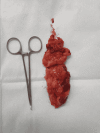Conn's Syndrome: An Unusual Cause of Periodic Paralysis
- PMID: 35702451
- PMCID: PMC9180667
- DOI: 10.7759/cureus.24880
Conn's Syndrome: An Unusual Cause of Periodic Paralysis
Abstract
Primary hyperaldosteronism, also known as Conn's syndrome, is characterized by an independent and excessive aldosterone production in the adrenal cortex, causing hypernatremia, arterial hypertension, and, in some cases, potentially severe hypokalemia can occur. We report a case of a 45-year-old Caucasian woman, with a history of obesity and hypertension, who presented to the emergency room with a four-week evolution history of myalgia and ascending muscle weakness eventually resulting in tetraparesis. The initial blood analysis showed severe hypokalemia (1.5 mmol/L). Further laboratory studies revealed an elevated plasma aldosterone level with low renin activity, and thyroid function tests were consistent with mild primary hyperthyroidism. CT scan showed a nodular lesion in the left adrenal gland. A saline suppression test confirmed that aldosterone secretion and renin activity were not suppressed. Regression of tetraparesis was noted with vigorous potassium supplementation. A laparoscopic left adrenalectomy was performed, with consequent normalization of hypokalemia, without the need for supplementation. Periodic paralysis (PP) are a rare group of neuromuscular diseases that occur due to the affection of the ion channels of the skeletal muscle. Most cases are hereditary; nonetheless, secondary causes of PP have been reported in the literature. This case illustrates an unusual and severe presentation of primary hyperaldosteronism manifested by PP. The concomitant changes in thyroid function raised the possibility that we are facing the clinical influence of another rare entity: thyrotoxic hypokalemic PP. However, the resolution of hypokalemia after the removal of adrenal adenoma supported the major contribution of hyperaldosteronism.
Keywords: conn´s syndrome; hyperaldosteronism; hypokalemia; neuromuscular diseases; periodic paralysis.
Copyright © 2022, Balhana et al.
Conflict of interest statement
The authors have declared that no competing interests exist.
Figures




Similar articles
-
Conn´s syndrome after kidney transplantation.Bratisl Lek Listy. 2024;125(4):258-263. doi: 10.4149/BLL_2024_39. Bratisl Lek Listy. 2024. PMID: 38526863
-
An additional child case of an aldosterone-producing adenoma with an atypical presentation of peripheral paralysis due to hypokalemia.J Endocrinol Invest. 2007 Nov;30(10):870-2. doi: 10.1007/BF03349230. J Endocrinol Invest. 2007. PMID: 18075291
-
Anesthetic Implications in Managing a Case of Primary Hyperaldosteronism: A Case Report.Cureus. 2023 Feb 26;15(2):e35502. doi: 10.7759/cureus.35502. eCollection 2023 Feb. Cureus. 2023. PMID: 37007341 Free PMC article.
-
Aldosterone-producing adenoma and other surgically correctable forms of primary aldosteronism.Orphanet J Rare Dis. 2010 May 19;5:9. doi: 10.1186/1750-1172-5-9. Orphanet J Rare Dis. 2010. PMID: 20482833 Free PMC article. Review.
-
Primary aldosteronism: renaissance of a syndrome.Clin Endocrinol (Oxf). 2007 May;66(5):607-18. doi: 10.1111/j.1365-2265.2007.02775.x. Clin Endocrinol (Oxf). 2007. PMID: 17492946 Review.
Cited by
-
The association between renin and thyroid-related biomarkers with clinical characteristics and outcomes in hyperthyroid patients.Sci Prog. 2025 Apr-Jun;108(2):368504251346842. doi: 10.1177/00368504251346842. Epub 2025 May 27. Sci Prog. 2025. PMID: 40420828 Free PMC article.
References
-
- Weber F, Lehmann-Horn F. GeneReviews®. Seattle: University of Washington; 2002. Hypokalemic periodic paralysis; pp. 1993–2022. - PubMed
-
- Paralisia periódica tireotóxica. Vale J, Canas N, Leal A, et al. https://www.researchgate.net/publication/7167740_Thyrotoxic_periodic_par.... Acta Médica Portuguesa. 2005;18:399–402. - PubMed
-
- Secondary hypokalemic periodic paralysis as a rare clinical presentation of Conn syndrome. Nicoletti T, Modoni A, Silvestri G. Clin Neurophysiol. 2018;129:2505–2506. - PubMed
Publication types
LinkOut - more resources
Full Text Sources
Miscellaneous
